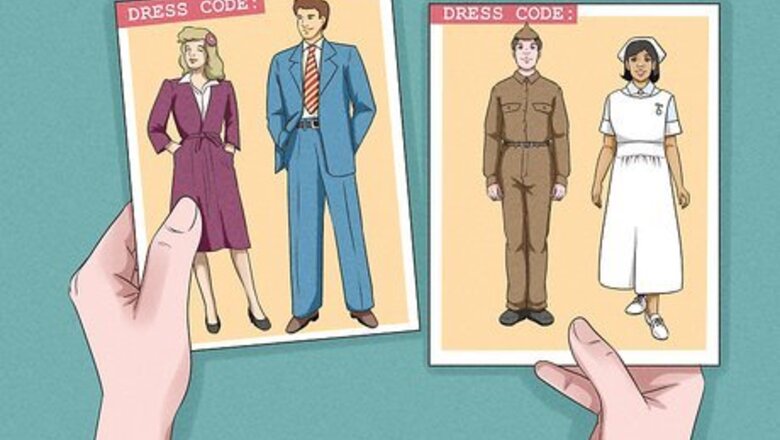
views
Let your guests know what they should wear.
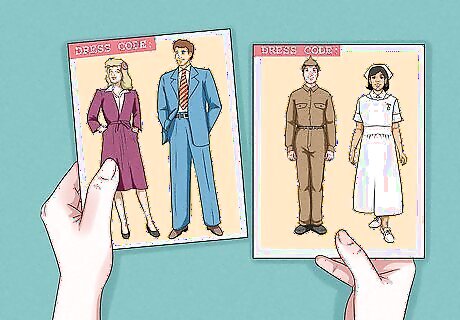
Send them a few examples of 1940s dress. Include your dress code information in the invitation or set up a website or event page with tips on how to dress for the era. For instance, feminine guests might wear skirts or dresses with hems that fall just below the knee, and accessorize with peep-toe shoes, gloves, hose, and head scarves. Masculine guests could wear single-breasted suits or slim-fitting trousers with bomber jackets. Zoot suits—which were were draped with more fabric—became popular in this era, as well. Guests can also wear military or 1940s-era nurse uniforms. You could even send out tutorials for how to do victory rolls, a popular hairstyle for women in the 1940s. You might also include links to 1940s-themed makeup tutorials—red lipstick was especially popular. To really get everyone in the spirit, hold a costume contest once all of your guests arrive!
Serve classic sodas and cocktails.
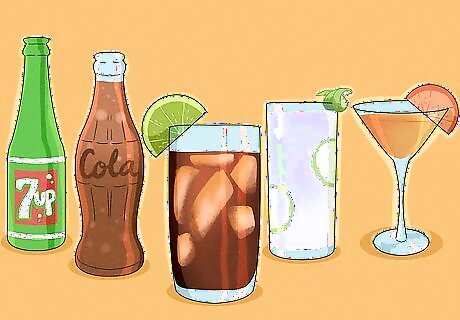
Offer a variety of drinks that were popular during the 40s. In the 1940s, soda fountains were a popular gathering spot, so be sure to serve sodas like Coca-Cola, 7-Up, and Dr. Pepper at your party. If you can find them, consider serving these in glass bottles to feel true to the era! If you want to include a few of the cocktails from the era, try mixing up some daiquiris, Cuba Libre, Gin Rickeys, or Sidecars for your guests. Daiquiris were especially popular because rum was able to be freely imported from Cuba, Latin America, and the Caribbean. No need to break out the blender—in the 1940s, daiquiris weren't served frozen. Instead, they were simply made by mixing 1 ⁄2 fl oz (44 ml) of light rum, ⁄4 fl oz (22 ml) of lime juice, and ⁄2 fl oz (15 ml) of simple syrup.
Show off your historical knowledge with foods from the era.
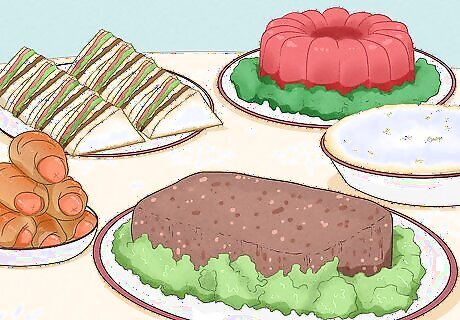
Look up recipes for foods that were common in this time. During the war, food rations meant that it was sometimes hard to get things like eggs, meat, and butter. That meant cooks had to get creative to serve up nutritious and tasty food for their family, and you can do the same thing for your guests. If you're having a full meal, set out a buffet with classic foods like meatloaf, Spam, mashed potatoes, potato salad with hot dogs, coleslaw, egg salad, and brown bread. If you'd rather serve finger foods, opt for things like assorted sandwiches, scones or spiced biscuits with jam, cheese and potato dumplings, vegetable turnovers, sausage rolls, and potato cakes. Include a few sweets, as well—boxed cake mixes were popular, as were Jell-O salads, applesauce, coconut cream pie, and molasses cookies. You could even include candies like Mike & Ikes, M&Ms, and York Peppermint Patties.
Send out invitations with the party info.
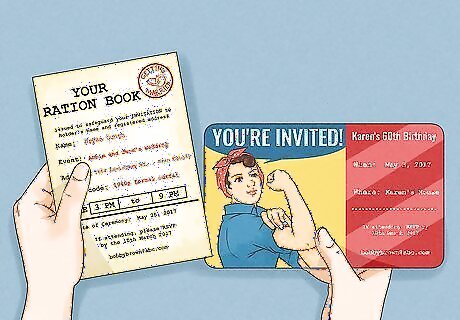
Get creative with 1940s-era images. World War 2 dominated most of the 1940s, and the posters and photographs from the time can be great inspiration for your invitations. For instance, you might have a picture of Uncle Sam saying "I Want You" on the front of the invitation, then "to come to my 1940s-themed party!" on the inside, along with the date, time, and location of the event. You could also use other war-themed imagery, like Rosie the Riveter, the iconic photo of a soldier kissing a nurse as he returned home, or even a modified version of the ration cards that were used during the time. You might also design your invitations to look like an old newspaper, complete with a historical headline! Feel free to get creative with other popular images from the time, like private eye movies or pin-up girls—look up photographs and ads from the time for even more ideas! Consider picking a party date with historical significance, like the end of the war in Europe (May 8) or the premiere of the film Casablanca (November 26).
Rent a space at a historical location to reinforce the theme.
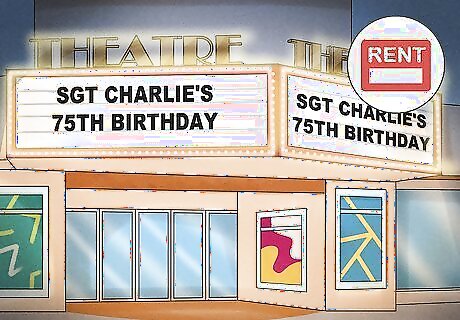
You could also decorate your home if you have enough space. If you're able to, try having your party at a building that was used during the 1940s. Old movie theaters, historic hotels, museums, or historic bars make great venues, for instance. If nothing like that is available in your budget, look for a venue that has some of the design elements that were popular in the 40s—buildings tended to be streamlined and uncluttered, with jewel-toned decor, wood paneling or floral wallpaper, and Colonial-style furniture. If you don't want to rent a venue, it's perfectly fine to have your party at home or at a friend's house, as long as you have space for all of your guests!
Decorate with a patriotic flair to reflect the times.
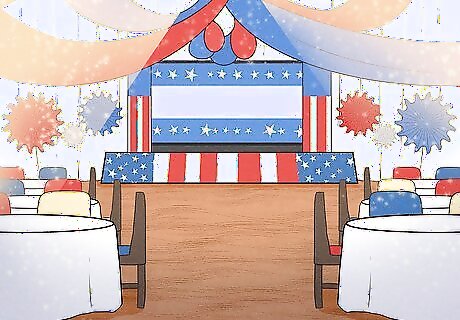
Incorporate red, white, and blue into your decor. Party decorations often included these colors, so use plenty of them in your party for a really authentic touch. Use streamers, banners, colored light bulbs, and pinwheels to help your party feel festive, even on a budget. You can also decorate with flags—like the American flag if you live in the US or the Union Jack if you live in the UK. Wartime propaganda posters, photos of bomber planes, bugles, and vintage radios will all add to the look of your party, as well. When you're budgeting for decorations, it's a good idea to plan your most expensive costs first, like your food and drinks. Then, look at what you have left over to make sure your design plan is really feasible. Hawaiian and tiki-themed parties and decorations became popular during this time, so consider including a few tropical flowers in your decor, or give guests leis or flowers for their hair.
Add decorative touches taken from 1940s pop culture.
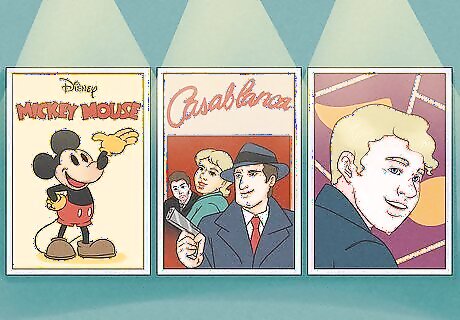
Hang posters and photos of popular characters. Bring your 1940s party to life by pulling in some of the other popular icons from the era. Characters like Superman, Mickey Mouse, and Little Orphan Annie were all popular, and they'll make your guests feel like they really stepped back in time. You might also include popular toys from the time, like Slinkies and Frisbees. Consider movie posters from 1940s films like: Casablanca, Citizen Kane, or Yankee Doodle Dandy. You can also print posters of iconic musicians like Bing Crosby or Frank Sinatra. Consider surrounding these posters with old records or musical instruments like horns.
Play music from the 1940s.
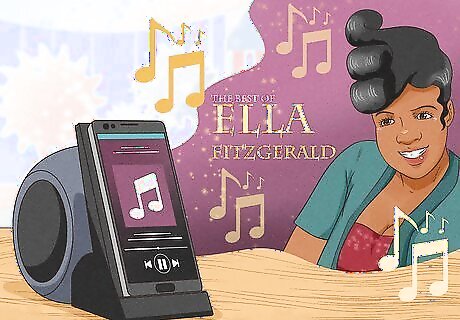
Swing, big band, and jazz were especially popular. Much of the popular music from the 1940s was upbeat, making it perfect for a party. Play songs from the most popular musicians of the era, like Frank Sinatra, Benny Goodman, Bing Crosby, and Glenn Miller. You can also get jazzy with artists like Ella Fitzgerald, Nat King Cole, and Louis Armstrong. Latin musicians like Carmen Miranda and Tito Puente began rising in popularity during this time. Country and Western was also popular—consider mixing in a couple of songs from Gene Autry, Roy Rogers, and Tex Williams. If you have the budget, hire a band to play Big Band music for a really authentic feel!
Play games that were popular in that time period.
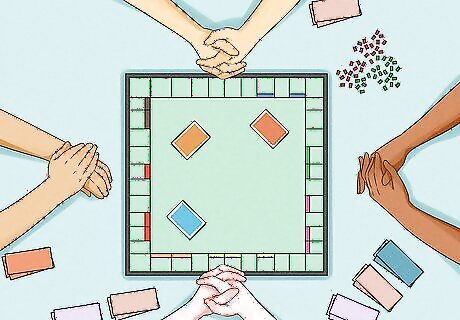
Go back in time with board and card games. Liven up your party by setting up tables with board games like Scrabble, Monopoly, Candy Land, Chutes and Ladders, checkers, chess, and Backgammon. You can also host card games like Crazy Eights, Hearts, and Gin Rummy. Offer prizes like framed photos of 1940s-era Hollywood stars or extra rations of party favors. Try hosting Bingo for another fun, historically accurate party game. You could also set up games like bowling or marbles, which were popular at the time.
Teach your guests dances from the 1940s
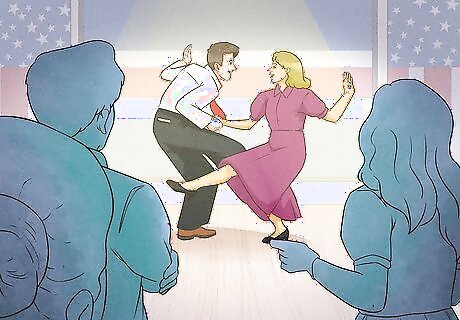
Watch tutorials and learn a few steps. In the 40s, dancing was a popular way for people to get their minds off of the war and just have fun for a while. So what better way to celebrate that era than having a swing dancing lesson at your party? You could hire a dance instructor, or you could just learn a few moves on your own, then teach them to your guests. Swing dances like the Jitterbug and Lindy Hop were popular at the time, as were Latin- and African-influenced dances like the rumba and samba. Make sure to play a few songs that are compatible with the Jitterbug after your guests have learned it, so they can have fun with their new dance skills.
Set up a photo booth to capture the fun.
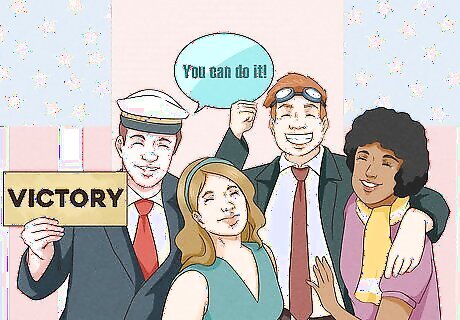
Include dress-up items and other props. Photo booths have become mainstays of parties in recent years, and they are excellent ways to reinforce your party theme. Rent one from a party supply store, or make your own by setting up a space in the corner of your venue. You can either partition your DIY photo booth with curtains, or you can simply set up a backdrop with paper and decorations. Then, include instant cameras so guests can snap photos. Include 1940s-era purses, hats, and gloves, along with things like military caps, nurse's hats, draft cards, vintage newspapers, and any other props you can dream up!
Project historic video footage during the party.
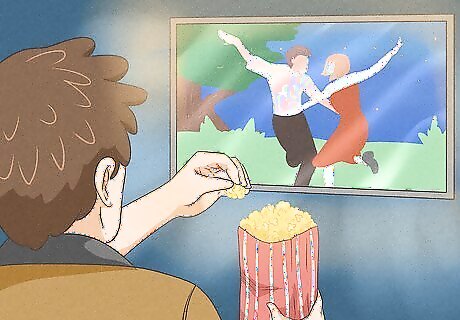
Set up a projector to feature your footage. Truly capture the 1940s with authentic footage from the time. Use clips from Hollywood movies, newsreels, and commercials. You can find a wealth of footage in the public domain from this period online—at sites like the UK's National Archive site, the Internet Archive, and even YouTube. Edit the footage to create a montage of 1940s clips to play on loop the day of your party. If you need help editing the film, search for online tutorials or check out the media help desk at your nearest public library. On the day of your party, project the footage onto a wall or white sheet. Alternatively, you can use a large screen or television, but a projected video will appear grainier, so it'll have a more historic look. You probably want to set the footage on silent, so guests can converse with one another and enjoy other music or entertainment.











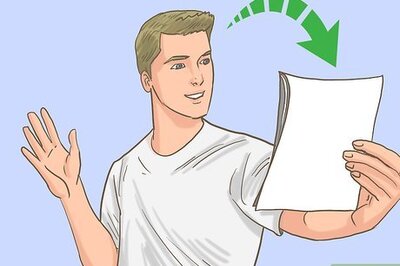





Comments
0 comment